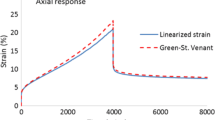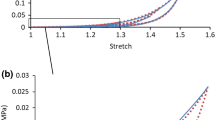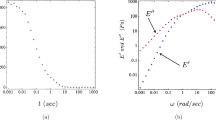Abstract
We formulate a constitutive framework for biodegradable polymers that accounts for nonlinear viscous behavior under regimes with large deformation. The generalized Maxwell model is used to represent the degraded viscoelastic response of a polymer. The large-deformation, time-dependent behavior of viscoelastic solids is described using an Ogden-type hyperviscoelastic model. A deformation-induced degradation mechanism is assumed in which a scalar field depicts the local state of the degradation, which is responsible for the changes in the material’s properties. The degradation process introduces another timescale (the intrinsic material clock) and an entropy production mechanism. Examples of the degradation of a polymer under various loading conditions, including creep, relaxation and cyclic loading, are presented. Results from parametric studies to determine the effects of various parameters on the process of degradation are reported. Finally, degradation of an annular cylinder subjected to pressure is also presented to mimic the effects of viscoelastic arterial walls (the outer cylinder) on the degradation response of a biodegradable stent (the inner cylinder). A general contact analysis is performed. As the stiffness of the biodegradable stent decreases, stress reduction in the stented viscoelastic arterial wall is observed. The integration of the proposed constitutive model with finite element software could help a designer to predict the time-dependent response of a biodegradable stent exhibiting finite deformation and under complex mechanical loading conditions.
Similar content being viewed by others
References
Agrawal C.M., Haas K.F., Leopold D.A., Clark H.G.: Evaluation of poly(L-lactic acid) as a material for intravascular polymeric stents. Biomaterials 13, 176–182 (1992)
Baek S., Pence T.J.: On mechanically induced degradation of fiber reinforced hyperelastic materials. Math. Mech. Solids 16, 406–434 (2011)
Ball J.M.: Convexity conditions and existence theorems in nonlinear elasticity. Arch. Ration. Mech. An. 63, 337–403 (1977)
Bergström J.S., Boyce M.C.: Constitutive modeling of large strain time-dependent behavior of elastomers. J. Mech. Phys. Solids 46, 931–954 (1998)
Booth C.: The mechanical degradation of polymers. Polymers 4, 471–478 (1963)
Chen R., Tyler D.R.: Origin of tensile stress-induced rate increases in the photochemical degradation of polymers. Macromolecules 37, 5430–5436 (2004)
Chen R., Yoon M., Smalley A., Johnson D.C., Tyler D.R.: Investigation of the origin of tensile stress-induced rate enhancements in the photochemical degradation of polymers. J. Am. Chem. Soc. 126, 3054–3055 (2004)
Chu, C.C.: Strain-accelerated hydrolytic degradation of synthetic absorbable sutures; surgical research, recent developments. In: Proceedings of the First Annual Scientific Session of the Academy of Surgical Research, Pergamon Press, San Antonio, pp. 111–115 (1985)
Ciarlet P.G.: Three-Dimensional Elasticity. Elsevier, Amsterdam (1988)
Coleman B.D., Noll W.: The thermodynamics of elastic materials with heat conduction and viscosity. Arch. Rational Mech. Anal. 13, 167–178 (1963)
Colombo A., Karvouni E.: Biodegradable stents: fulfilling the mission and stepping away. Circ. 102, 371–373 (2000)
Cuitino A., Ortiz M.: A material-independent method for extending stress update algorithms from small-strain plasticity to finite plasticity with multiplicative kinematics. Eng. Comput. 9, 255–263 (1992)
El Sayed, T.: Constitutive Models for Polymers and Soft Biological Tissues. PhD thesis California Institute of Technology (2007)
Fancello E., Ponthot J.P., Stainier L.: A variational formulation of constitutive models and updates in non-linear finite viscoelasticity. Int. J. Numer. Meth. Eng. 65, 1831–1864 (2006)
Gopferich A.: Polymer degradation and erosion: mechanisms and applications. Eur. J. Pharm. Biopharm. 4, 1–11 (1996)
Grabow N., Bunger C.M., Sternberg K.: Mechanical properties of a biodegradable balloon-expandable stent from poly(L-lactide) for peripheral vascular application. ASME J. Med. Devices 1, 84–88 (2007)
Grabow N., Schlun M., Sternberg K.: Mechanical properties of laser cut poly-L lactide microspecimens: implications for stent design, manufacture, and sterilization. J. Biomech. Eng. 127, 25–31 (2005)
Gutwald R., Pistner H., Reuther J., Muhling J.: Biodegradation and tissue reaction in a long-term implantation study of poly(L-lactide. J. Mater. Sci. Mater. Med. 5, 485–490 (1994)
Holzapfel G.: A new viscoelastic constitutive model for continuous media at finite thermomechanical changes. Int. J. Solids Struct. 33(20–22), 3019–3034 (1996)
Holzapfel G.A., Gasser T.C., Ogden R.W.: A new constitutive framework for arterial wall mechanics and a comparative study of material models. J. Elast. 61, 1–48 (2000)
Holzapfel G.: Nonlinear Solid Mechanics: A Continuum Approach for Engineering. 1st edn. Wiley, New York (2000)
Holzapfel G., Ogden R.: Constitutive modelling of arteries. Proc. R. Soc. A Math. Phys. Eng. Sci. 466(2118), 1551–1597 (2010)
Kleuter B., Menzel A., Steinmann P.: Generalized parameter identification for finite viscoelasticity. Comput. Methods Appl. Mech. Eng. 196(35–36), 3315–3334 (2007)
Knowles J.K.: Finite anti-plane shear field near tip of a crack for a class of incompressible elastic solids. Int. J. Fract. 13, 611–639 (1977)
Langer R.: Drug delivery and targeting. Nature 392(6679), 5–10 (1998)
Lee E.H.: Elastic plastic deformation at finite strains. J. Appl. Mech. 36, 1–6 (1969)
Levenberg, S., Langer, R.: Advances in tissue engineering. In: Schatten, G.P. (ed.) Current Topics in Developmental Biology, Number 61, 1st edn, Elsevier, San Diego, pp. 113–134 (2004)
Lubarda V.A., Benson D.J., Meyers M.A.: Strain-rate effects in rheological models of inelastic response. Int. J. Plast. 19, 1097–1118 (2003)
Miller N.D., Williams D.F.: The in vivo and in vitro Degradation of poly(glycolic acid) suture material as a function of applied strain. Biomaterials 5(6), 365–368 (1984)
Moore J.E., Soares J.S., Rajagopal K.R.: Biodegradable Stents: biomechanical modeling challenges and opportunities. Cardiovasc. Eng. Technol. 1, 52–65 (2010)
Muliana A.H., Rajagopal K.R.: On the response of viscoelastic biodegradable polymeric solids. Mech. Res. Commun. 39(1), 51–58 (2011)
Ogden R.W.: Non-linear Elastic Deformations. Ellis Horwood, Chichester (1984)
Ortiz M., Molinari A.: Effect of strain-hardening and rate sensitivity on the dynamic growth of a void in a plastic material. J. Appl. Mech.-T. ASME 59, 48–53 (1992)
Ortiz M., Stainier L.: The variational formulation of viscoplastic constitutive updates. Comput. Method. Appl. M. 171(3–4), 419–444 (1999)
Ortiz M., Radovitzky R.A., Repetto E.A.: The computation of the exponential and logarithmic mappings and their first and second linearizations. Int. J. Numer. Meth. Eng. 52, 1431–1441 (2001)
Pişkin, E., Tuncel, A., Denizli, A., Denkbaş, E.B., Ayhan, H., Çiçek, H., Xu, K.T.: Nondegradable and biodegradable polymer particles-preparation and some selected biomedical applications. In: Usmani, A., et al. (eds.) Diagnostic Biosensor Polymers, ACS Symposium Series, American Chemical Society, Washington, DC, pp. 222–223 (1994)
Pistner H., Bendix D.R., Muhling J., Reuther J.F.: Poly(L-lactide)—a long-term degradation study in vivo. 3. Analytical characterization. Biomaterials 14, 291–298 (1993)
Rajagopal K.R., Srinivasa A.R., Wineman A.S.: On the shear and bending of a degrading polymer beam. Int. J. Plast. 23(9), 1618–1636 (2007)
Rajagopal K.R., Wineman A.S.: A constitutive equation for nonlinear solids which undergo deformation induced microstructural changes. Int. J. Plast. 8(4), 385–395 (1992)
Reese S., Govindjee S.: A theory of finite viscoelasticity and numerical aspects. Int. J. Solids Struct. 35, 3455–3482 (1998)
Renouf G.A.C., Rose J., Farrar D.F., Cameron R.E.: The effect of crystallinity on the deformation mechanism and bulk mechanical properties of plla. Biomaterials 26, 5771–5782 (2005)
Schmitt L.M.: Theory of genetic algorithms II: models for genetic operators over the string-tensor representation of populations and convergence to global optima for arbitrary fitness function under scaling. Theor. Comput. Sci. 310, 181–231 (2004)
Sidoroff F.: Un modèle viscoélastique non linéaire avec configuration intermédiaire. J. Mécanique 13, 679–713 (1974)
Soares J.S., Moore J.E., Rajagopal K.R.: Constitutive framework for biodegradable polymers with applications to biodegradable stents. ASAIO J. 54(3), 295–301 (2008)
Soares J.S., Rajagopal K.R., Moore J.E.: Deformation-induced hydrolysis of a degradable polymeric cylindrical annulus. Biomech. Model. Mechanobiol. 9(2), 177–186 (2010)
Soares, J.S.: Constitutive Modeling for Biodegradable Polymers for Applications in Endovascular Stents. PhD thesis Texas A and M University (2008)
Tammela T.L., Talja M.: Biodegradable urethral stents. BJU Int. 92, 843–850 (2003)
Weinberg K., Mota A., Ortiz M.: A variational constitutive model porous metal plasticity. Comput. Mech. 37, 142–152 (2006)
Wineman A., Min J.H.: The pressurized cylinder problem for nonlinear viscoelastic materials with a strain clock. Math. Mech. Solids 1, 393–409 (1996)
Yang Q., Stainer L., Ortiz M.: A variational formulation of the coupled thermo-mechanical boundary-value problem for general dissipative solids. J. Mech. Phys. Solids 54, 401–424 (2006)
Author information
Authors and Affiliations
Corresponding author
Rights and permissions
About this article
Cite this article
Khan, K.A., El-Sayed, T. A phenomenological constitutive model for the nonlinear viscoelastic responses of biodegradable polymers. Acta Mech 224, 287–305 (2013). https://doi.org/10.1007/s00707-012-0760-7
Received:
Published:
Issue Date:
DOI: https://doi.org/10.1007/s00707-012-0760-7




